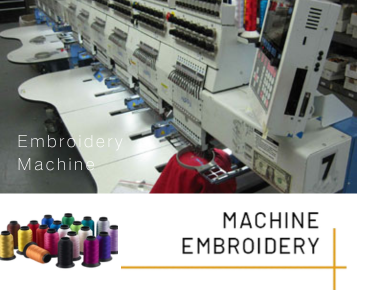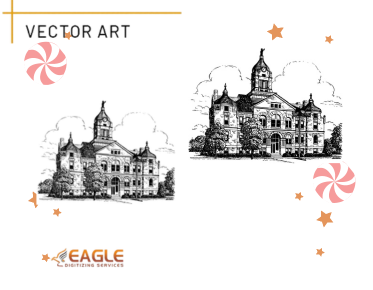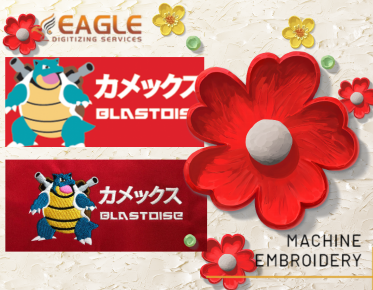Hand vs. Machine Embroidery: Benefits Simplified for You
Embroidery is a cherished craft that has been practiced for centuries, evolving from hand techniques to advanced machine-assisted processes. Comparing machine and hand embroidery sheds light on the strengths of each, but machine embroidery often stands out for its efficiency and precision. This article explores the numerous benefits of machine embroidery, providing insights into why it might be the superior choice for many projects. Use these guidelines from Eagle Digitizing to find the best machine for your needs.
Speed and Efficiency
How Machine Embroidery Saves Time
Machine embroidery significantly reduces the time required to complete projects. Once a design is put into the machine, it can be carried out rapidly and consistently, much beyond the speed of manual stitching. This efficiency is especially beneficial for large or complex designs.
The Speed Advantage: Completing Projects Quickly
Machine embroidery machines are designed to handle multiple stitches per minute, allowing for rapid completion of embroidery tasks. This speed advantage makes machine embroidery an ideal choice for commercial production or when facing tight deadlines.
Efficiency in Production: How Machines Handle Multiple Designs
Machines can be programmed to handle multiple designs in succession, making them perfect for bulk orders and varied product lines. This capability ensures that designs are produced with uniform quality and reduces the need for frequent manual setup changes.
Precision and Consistency
Achieving Precision with Machine Embroidery
Machine embroidery offers exceptional precision due to its computerized nature. The machine follows the design file exactly, ensuring that each stitch is placed with pinpoint accuracy. This precision is crucial for maintaining the integrity of detailed patterns and designs.
Consistency Across Designs: Why Machines Excel
Consistency is a hallmark of machine embroidery. Unlike hand embroidery, where slight variations can occur, machines produce identical results across multiple items. This consistency is essential for creating professional-quality products, especially in commercial applications.
How Machine Embroidery Reduces Human Error
Machine embroidery minimizes human error by automating the stitching process. Errors such as uneven stitches or misaligned patterns are significantly reduced, ensuring a flawless finish with each project. The machine’s precision and automation enhance overall design quality and reliability.
Complex Designs and Details
Machine Embroidery for Intricate Designs: Capabilities and Benefits
Machine embroidery excels in handling complex and intricate designs that might be challenging to achieve by hand. Advanced machines can execute detailed patterns with fine lines and multiple colors, making them ideal for elaborate embroidery projects.
How Machines Handle Detailed Patterns and Fine Details
Machines are equipped with features that enable them to manage fine details effectively. High-resolution design files and precise stitch control allow machines to reproduce delicate elements with accuracy. This capability ensures that even the most intricate designs are rendered beautifully.
Creating Complex Embroidery Easily with Technology
Technology simplifies the creation of complex embroidery by automating many of the detailed processes involved. Software tools allow for easy adjustments and modifications to designs, making it simpler to incorporate intricate details and achieve sophisticated results.
Cost-Effectiveness
Comparing Costs: Machine vs. Hand Embroidery
While the initial investment in embroidery machines can be substantial, machine embroidery often proves more cost-effective in the long run. Machines reduce labor costs, enhance production speed, and minimize material waste, leading to overall savings compared to hand embroidery.
How Machine Embroidery Can Lower Production Costs
Machine embroidery can lower production costs by increasing efficiency and reducing the need for manual labor. Bulk production capabilities and reduced stitching time contribute to cost savings, making it an economical choice for large-scale projects and commercial enterprises.
Investing in Machines: Long-Term Savings and Benefits
Investing in an embroidery machine offers long-term benefits, including increased productivity and consistent quality. Over time, the cost savings from reduced labor and enhanced efficiency can outweigh the initial investment, providing a solid return on investment for businesses and serious hobbyists alike.
Customization and Flexibility
Personalizing Designs with Machine Embroidery
Machine embroidery allows for easy personalization and customization of designs. By adjusting design files and machine settings, users can create unique, tailored items quickly and accurately. This flexibility is particularly advantageous for creating custom apparel and personalized gifts.
How Machines Offer Flexibility for Different Projects
Embroidery machines offer flexibility by accommodating a wide range of design options and fabric types. Whether working with delicate fabrics or thick materials, machines can be adjusted to handle different project requirements, making them versatile tools for various embroidery tasks.
Adapting Designs Quickly: The Benefits of Machine Adjustment
Machines allow for quick adjustments to designs and settings, facilitating rapid changes and modifications. This adaptability is beneficial for projects that require frequent design updates or customizations, streamlining the process and enhancing workflow efficiency.
Quality and Durability
Quality of Machine Embroidery: What to Expect
Machine embroidery delivers high-quality results with consistent stitching and precise color application. The automation of the process ensures that each item meets professional standards, providing a polished and durable finish.
Durability of Machine-Embroidered Products Compared to Handwork
Machine-embroidered products are generally more durable than hand-embroidered items. The uniformity and consistency of machine stitching contribute to longer-lasting designs, reducing the risk of wear and tear compared to manually stitched items.
How Machines Ensure Consistent Quality Over Time
Machine embroidery ensures consistent quality by automating the stitching process and maintaining precise settings throughout production. This consistency reduces variations and ensures that each product adheres to the same high standards, regardless of the production volume.
Ease of Use and Learning Curve
Learning to Use an Embroidery Machine: What to Know
Learning to use an embroidery machine involves understanding its features, settings, and software. While there is a learning curve, modern machines are designed with user-friendly interfaces and instructional resources to facilitate the learning process. For the top-notch online embroidery digitization, don't hesitate to get in touch with us.
Comparing the Learning Curve: Machine vs. Hand Embroidery
The learning curve for machine embroidery can be steeper initially compared to hand embroidery. However, once mastered, machine embroidery offers greater ease and efficiency, making it a valuable skill for those looking to streamline their embroidery projects.
How Machines Simplify the Embroidery Process for Beginners
Embroidery machines simplify the process for beginners by automating many of the complex tasks involved in hand stitching. User-friendly controls, pre-set designs and automated functions make it easier for newcomers to achieve professional-quality results with minimal effort.
Production Volume and Scalability
Handling Large Orders with Machine Embroidery
Machine embroidery excels at handling large orders efficiently. The ability to program and automate multiple designs allows for rapid production of high quantities, making it ideal for businesses and bulk projects.
Scaling Up Production: How Machines Support Bulk Work
Machines support scalability by enabling the production of large volumes of embroidered items with consistent quality. Features such as multi-needle systems and large hoop sizes facilitate the efficient scaling of production to meet high-demand needs.
Benefits for Businesses: Meeting High-Demand Needs Efficiently
Machine embroidery allows firms to efficiently satisfy high-demand requirements. The speed and consistency of machine embroidery ensure that large orders are fulfilled promptly, helping businesses maintain customer satisfaction and profitability.
Design Versatility
Machine Embroidery and Its Range of Design Options
Machine embroidery provides a broad range of design options, from simple monograms to intricate patterns. The ability to create diverse designs with precision and speed enhances creative possibilities and allows for a wide array of embroidery projects.
How Machines Accommodate Various Types of Fabric and Thread
Machines are designed to handle different types of fabrics and threads, offering versatility in project materials. Whether working with lightweight fabrics or heavy-duty textiles, machines can be adjusted to ensure optimal stitching results for various materials.
Exploring Creative Possibilities with Machine Embroidery
Machine embroidery opens up creative possibilities by allowing for the exploration of complex designs and innovative techniques. Advanced features and software tools enable users to experiment with new ideas and push the boundaries of traditional embroidery.
Error Correction and Troubleshooting
How Machines Handle and Correct Errors Automatically
Many embroidery machines come equipped with error detection and correction features. These functions automatically address issues such as thread breaks or misalignments, reducing the need for manual intervention and ensuring a smoother embroidery process.
Troubleshooting Common Issues in Machine Embroidery
Common issues in machine embroidery include thread tension problems, design misalignments, and stitch irregularities. Troubleshooting these issues involves checking machine settings, reviewing design files, and making necessary adjustments to resolve problems.
How to Minimize and Manage Errors in Machine Projects
Minimizing errors in machine embroidery involves regular maintenance, proper calibration, and careful monitoring of the embroidery process. Implementing best practices for setup and using high-quality materials can help manage and reduce potential errors.
Maintenance and Longevity
Maintaining Your Embroidery Machine: What to Expect
Regular maintenance of embroidery machines includes cleaning, lubricating, and checking for wear and tear. Following the manufacturer's maintenance guidelines helps ensure the machine remains in optimal condition and extends its lifespan.
Longevity of Machines vs. Hand Tools
Embroidery machines generally have a longer lifespan compared to hand tools due to their robust construction and advanced technology. Proper maintenance and care contribute to the longevity of machines, providing reliable performance over time.
Regular Maintenance Tips for Prolonging Machine Life
To prolong the life of your embroidery machine, perform regular cleaning, inspect and replace worn parts, and follow recommended maintenance schedules. Keeping the machine in good condition helps prevent breakdowns and ensures consistent performance.
Speed of Learning and Training
Training Time for Machine Embroidery: What’s Involved
Training for machine embroidery involves learning to operate the machine, understanding software, and mastering design techniques. While initial training may take time, the investment in learning pays off with increased efficiency and productivity.
How Machine Embroidery Training Compares to Hand Techniques
Machine embroidery training typically involves fewer manual skills compared to hand techniques. Once the machine is set up and the software is understood, the process becomes more streamlined and less labor-intensive than hand embroidery.
Tips for Efficiently Learning Machine Embroidery
To learn machine embroidery efficiently, start with basic projects, utilize instructional resources, and practice regularly. Familiarizing yourself with the machine's features and software will enhance your proficiency and confidence.
Environmental and Ergonomic Considerations
How Machine Embroidery Impacts Your Workspace
Machine embroidery can impact your workspace by requiring dedicated space for the machine and its accessories. Proper organization and setup can optimize the workspace and enhance workflow efficiency.
Ergonomic Benefits of Using a Machine Over Hand Embroidery
Machine embroidery offers ergonomic benefits by reducing the physical strain associated with manual stitching. The automation of the process minimizes repetitive motions, making it more comfortable for users and reducing the risk of strain injuries.
Environmental Considerations: Machines vs. Handwork
Environmental considerations for machine embroidery include energy consumption and the disposal of electronic components. While machine embroidery may have a higher environmental impact compared to handwork, implementing sustainable practices and proper recycling can help mitigate these effects.
Market Trends and Demand
Current Market Trends Favoring Machine Embroidery
Current market trends show a growing preference for machine embroidery due to its efficiency, precision, and ability to handle large orders. The demand for customized and personalized products has further driven the popularity of machine embroidery.
How Machine Embroidery Meets Modern Consumer Demands
Machine embroidery satisfies today's consumer demands by providing high-quality, personalized items with quick turnaround times. The ability to produce detailed and personalized items efficiently aligns with contemporary consumer expectations.
Future Prospects: The Growing Popularity of Machine Embroidery
The future of machine embroidery looks promising as technological advancements continue to enhance its capabilities. The growing interest in customization and efficiency suggests that machine embroidery will remain a key player in the embroidery industry.
Machine embroidery offers numerous benefits over hand embroidery, including speed, precision, and cost-effectiveness. By understanding and leveraging these advantages, individuals and businesses can achieve high-quality results with greater efficiency. Exploring machine embroidery provides opportunities for creative expression and professional growth, making it a valuable tool for any embroidery enthusiast or professional.



